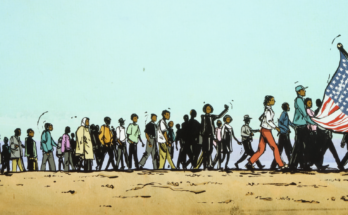American music tells the stories of people who came together — some by choice, others by force — to form a diverse nation bound by a common idea: freedom. Whether sacred or secular, their songs weave tales of awe and wonder at the wide open spaces around them, of thankfulness for God’s bounty, of mourning for homelands they may never see again, of the sheer joy of life, and a thousand other emotions. The melodies reflect a range of traditions and cultures from indigenous peoples to European, African and others, blending together to create new forms that are distinctly American.
These stories, cultures, traditions and the music they inspired are the subject of “New Harmonies: Celebrating American Roots Music,” a traveling exhibition that explores the early traditions of American music. The exhibit will visit 12 Georgia towns beginning in April 2012 and continuing through November 2013.
“New Harmonies” is part of the Museum on Main Street collaboration between the Smithsonian Institution and state humanities councils nationwide. The program brings quality museum exhibitions, organized and curated by Smithsonian staff, to small town museums and rural Americans. Exhibitions focus on broad topics of national history, and have included the World War II homefront experience, the historic significance of barns and American farm families, and America’s regional food traditions, among others.
Each exhibit includes information panels and photos as well as objects from the Smithsonian’s collection and interactive displays. “New Harmonies,” for example, will include musical instruments, a radio that plays broadcasts from the past, and a listening station where visitors can experience various types of music.
As part of the Museums on Main Street program, participating communities are encouraged to supplement the exhibition, through programs and activities that celebrate their own local heritage and culture. These might include scavenger hunts, performances or lectures by local experts, oral history programs and more.
“When Smithsonian assembles an exhibit, they do it in a very general way to reflect the entire nation,” explains Arden Williams, senior program officer for the Georgia Humanities Council. “It’s then up to the participating communities to tailor the exhibit to their own regions. Each of the 12 participating communities had to submit ideas for programs, and each has a strong tie to roots music.”
“New Harmonies” is the latest Smithsonian exhibit to visit Georgia. In 2009-10, Georgia Humanities Council co-sponsored “Key Ingredients,” which focused on America’s regional food traditions. The exhibit was a great success, not only for the Council, but for the participating communities.
“The impact of having a Smithsonian exhibit extends well beyond the six weeks that it is in a small town,” Williams says. “In addition to bringing positive attention to a community, the experience tends to generate changes and improvements.
“Hapeville now has its own cultural arts center as a result of hosting the food exhibit. Buchanan started a farmers market. Indian Springs began their program with two sponsors and ended up with more than 20, including many of the town’s small businesses. It’s a perfect example of communities working together to build success.”
Georgia is well known as the home to many successful musicians, in every genre from gospel to rhythm and blues, pop, rock, country and classical. Through the “New Harmonies” exhibit, Williams hopes Georgians will learn about the history and traditions that made their success possible.
“We hope visitors will learn more about the wonderful musical traditions that exist in Georgia – not just the music, but the stories behind it,” she says. “There are many, many people out there who are just amazing talents but are unknown outside their communities. This will be a great opportunity to recognize them and capture their stories for eternity.”
“New Harmonies” is sponsored by the Georgia Humanities Council, Smithsonian Institution, Center for Public History at the University of West Georgia, Georgia Dept. of Economic Development and the Atlanta Symphony Orchestra. For information about the exhibit, please visit the Georgia Humanities Council at georgiahumanities.org.



